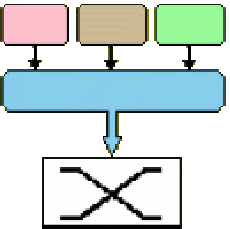|
The complexity of multi-service network control coupled with the need
to introduce new services quickly means that monolithic solutions are
inappropriate and other solutions must be found. Recent research at
Cambridge has shown how a low-level, service-based switch control
interface permits a sharp distinction to be made between the physical
network and the control layer. Control architectures that allow this
type of separation are termed open, as they can be implemented,
modified and maintained by parties other than the switch vendor.
Opening the switch's control has several advantages:
- control functions can be made switch-independent, so the same
control architecture implementation can manage different switches
in a similar way and the controlling and switching planes can
evolve independently;
- the switch controller and the switch fabric can be physically
separated, so the control architecture can be executed in an
environment potentially more powerful than that available on the
switch;
- since such a low-level interface can be controlled by any number
of different control architectures, network operators are free to
implement their own control architectures, either proprietary or
standard, in the way best suited to the services they wish to
support. In this way network operators can make decisions about
the nature and implementation of their control architectures
which are more congruent with the types of services that the
network they control is expected to support.
Other research, for example TINA,
XBind, has
also recognised the limitations of the current standards and attempted
to rectify them in a similar way. What distinguishes these approaches
from ours is that they attempt to replace the current monolithic
standard control architecture with another, perhaps more modular,
one. Our work shows that much more flexibility is attained by
accepting that no single ATM control architecture can ever be optimal
for all services and by defining a framework, which we have called the
Tempest, in which multiple control architectures, both standard
and proprietary, can be supported. There is no longer any need to
define one single `best' control architecture. A given fabric can be
managed simultaneously by many controllers if the resources of the
switch can be partitioned between them. Such a partition is called a
switchlet, because to each control architecture the partition
resembles a small switch. Although we have applied this approach to
ATM, it is a general technique which can be applied to any switching
technology with the consequent advantages.
The Network Control and Management Group was set up in Summer 1996.
The technology to allow the creation and policing of switchlets is the
subject of a patent and is currently being commercialised by Cplane Inc, a Bay Area start up.
|




